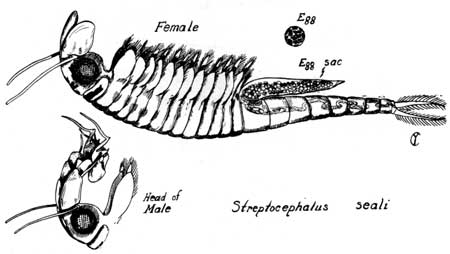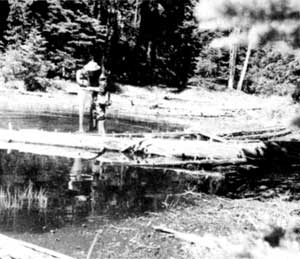Fairy Shrimp

Pen and ink sketch of Fairy Shrimp by Ranger-Naturalist Charles F. Yocum.
On July 27, while making some investigations of a group of small, shallow ponds on top of Whitehorse Bluff, the author, with Assistant Park Naturalist Donald S. Farner and Ranger-Naturalist James Kezer, found all five of the ponds visited thickly populated with fairy shrimp. Fairy shrimps belong to the animal group known as phyllopod crustaceans — small relatives of the crayfish, crab, and lobster. Many species of them are found only during the spring season, frequently in temporary ponds which may be in existence for only a few weeks. They emerge rapidly from eggs which were laid the previous season, soon grow to maturity, mate, lay their eggs, and thus complete their cycle.
 Ranger-Naturalist Fairbanks collecting in a temporary pond on Whitehorse Bluff. Photograph by Art C. Toth. |
The Whitehorse ponds, four of which were sampled, lie at an approximate elevation 6250 feet above sea level. They are mostly temporary, and some of the basins were completely dry before mid-August. At the time of the first visit to them, they were being fed by water from melting snowbanks along their shores. None was over thirty inches deep, and they were nestled in a forest of lodgepole pine and mountain hemlock.
The first pond, so-called North Whitehorse Pond, did not at first appear to have any of the fairy shrimp, and none were noticed until we had moved on to the second. Closer examination of the first sample, however, revealed a large number of very small, immature specimens. It may possibly be that this pond was formed later than those in which older individuals were found, although there was no further evidence to indicate that this was the case.
All specimens mature enough to be identified proved to be Streptocephalus seali (See Figure). Thanks are due Dr. Ralph W. Dexter, Professor of Biology at Kent State University, Kent, Ohio for the identification. Thanks are due also to Ranger-Naturalist Charles Yocom for the illustration which accompanies this note.
This same species was found by Ranger-Naturalist Kezer in Lake West, a small, permanent body of water about a mile beyond the park boundary, just outside the northwest part of Crater Lake National Park. He first observed them there during the last week in September, 1951, when they occupied the entire lake. On July 24, 1952 he again found them. This time, however, they were confined to the northwest section of the lake.

